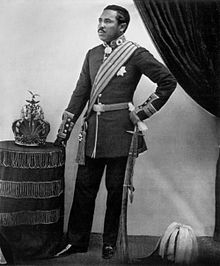First Madagascar expedition
| First Madagascar expedition (1883–1885) | |||||||
|---|---|---|---|---|---|---|---|
| Part of the Le Monde Illustré, 1883. | |||||||
| |||||||
| Belligerents | |||||||
|
|
| ||||||
| Commanders and leaders | |||||||
|
|
| ||||||
| Strength | |||||||
|
2 cruisers (Flore, Forfait) 1 scout ship (Vaudreuil) 1 aviso (Boursait) 1 gunboat (Pique) 1 aviso transport (Nièvre) | unknown | ||||||
| Casualties and losses | |||||||
| unknown | unknown | ||||||
| unknown | |||||||
The First Madagascar expedition was the beginning of the
British influence
Following their capture of Mauritius from the French in 1810 during the Napoleonic Wars, with ownership confirmed by the 1814 Treaty of Paris, the British saw Madagascar as a natural expansion of their influence in the Indian Ocean.[1] The Merina King, Radama I, managed to unite Madagascar under one rule, benefiting from British weapons and military instructors.[1] He signed treaties with the British, allowing Protestant missionaries and outlawing the slave trade.[2]
When Queen Ranavalona I took power in 1828, relationships with foreign powers gradually soured. By the mid-1830s, nearly all foreigners had chosen to leave or were expelled, and British influence was largely suppressed.[1][2] An exception, the Frenchman Jean Laborde, was able to remain in the island to build foundries and an armament industry.

Meanwhile, the Queen's son Prince Rakoto (future King
The Prime Minister Rainivoninahitriniony revoked the Lambert Treaty in 1863. From 1864, Prime Minister Rainilaiarivony endeavored to modernize the state by putting an end to slavery in 1877, modernizing the legal system in 1878 and setting up a new constitution in 1881.[3] Under the anglophile Rainilaiarivony, British influence grew considerably in the economic and religious fields.[1]
Growing French interests
In the early 1880s however, the French colonial faction, the right-wing Catholic lobby and
Expedition
The decision was taken to send the naval division of Admiral
When the ultimatum was refused, France bombarded the east coast, occupied Toamasina, and arrested the English missionary Shaw.[3][5] Meanwhile, Queen Ranavalona II died, as did Admiral Pierre, who succumbed to the fatigue of the campaign.[1] Admiral Pierre was replaced by Admiral Galiber, and then Counter-Admiral Miot.[1]
Aftermath
A Treaty was signed in December 1885, the French interpreting it as a Protectorate Treaty, while Queen Ranavalona III and Prime Minister Rainilaiarivony denied it.[3] The Treaty included the acceptance of a French resident in Antananarivo and the payment of an indemnity of 10 million.[1]
The Treaty however remained without effect, and would lead to the Second Madagascar expedition in 1895, which resulted in French colonization of Madagascar.[1]
See also
References
- ^ ISBN 2-35261-022-2.
- ^ ISBN 978-1-60693-494-4.
- ^ ISBN 978-0-85255-097-7.
- ISBN 978-0-543-95979-9.
- ^ ISBN 978-0-7146-1024-5.
